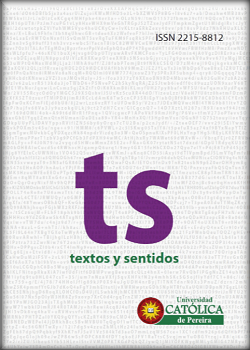Users’ emotional interactions with brands in Facebook social network: A content analysis from Valence Arousal Dominance (VAD)
Keywords:
Social networks, Emotional dimensions, Brand engagement, Content, InteractionAbstract
Social networks have become an increasingly presentphenomenon in the everyday world of Internet users,which has led brands to decide and take advantage ofthem as a space for direct communication since theycan establish talks with their target group.From a qualitative approach the researchers aimedto develop a descriptive cross-sectional study, whichwas based in content analysis allowing a systematicdescription and interpretation of generated andshared brand messages through Facebook semanticand formal components.The core interest has been establishing emotionalcomponents analysis categories, and determinetheir role as users’ action motivators and their brandcommitment. Based on the results and previouslearning, we tried to compare content effectivenesslevel with the metrics provided by Facebook,establishing possible guidelines in advertisingcommunication strategies.
References
Accenture (2013). Retail technology vision 2013. Retrieved from http://www.accenture.com/SiteCollectionDocuments/PDF/Accenture-Retail-Technology-Vision-2013.PDF
Berger ,J ; Milkman, k.l. ( 2012). What makes on line content viral? Journal of marketing research. Num 49 , Pag 192-205.
Berger, J ( 2013). contagious: why things catch on. Nueva York: simon & schuster
Cannon, WB (1927). La teoría de James-Lange de las emociones: Un examen crítico y una teoría alternativa. American Journal of Psychology, 39, 10-124.
Chayo-Dichy et al., (2003). Valencia, activación, dominancia y contenido moral, ante estímulos visuales con contenido emocional y moral: un estudio en población mexicana. Revista Española de Neuropsicología 5, 3-4: 213-225 REN ISSN: 1139-9872
Damasio, AR. (1999). Descartes ‘Error: La emoción, la razón y el cerebro humano. Putman: Nueva York.
Damasio A. (2000). The Feeling of what Happens: Body, Emotion and the Making of Consciousness
Danescu, Cheng, Kleinberg and Lee. (2012). You had me at hello: How phrasing affects memorability. In Proceedings of the ACL, Department of Computer Science. Cornell University
Darwin, C. (1872). La expresión de las emociones en el hombre y los animales (3ª edición). Appleton: Nueva York. Ekman, P. (1973). Cross-cultural studies of facial expressions. In P.
Ekman (Ed.), Darwin and facial expression: A century of research in review (pp. 169-229).
Goleman, D. (1995). La inteligencia emocional. Bantam Books: Nueva York.
Guerini M, Staiano J. and Albanese D. (2013). Exploring image virality in google plus. In Social Computing (SocialCom), International Conference on, pages 671–678. IEEE, 2013.
James, W. (1884). ¿Qué es una emoción? Mente, 9, 188-205.
Joinson, A. N. (2008). Looking at, looking up or keeping up with people? Motives and use of Facebook. Paper presented at the CHI conference on Human Factors in Computing Systems, Florence, Italy. Abstract retrieved from http://onemvweb.com/sources/sources/looking_at_motives_facebook.pdf
Kramer (2012). The spread of emotion via Facebook. Proc CHI (Association for Computing Machinery, New York), p 767–770.
Kramer, et al., (2014) Experimental evidence of massive-scale emotional contagion through social networks. Proceedings of the National Academy of Sciences, page 201320040
Lang, PJ, Bradley, MM, y Cuthbert, BN (2008). Sistema Internacional de Imágenes Afectivas (IAPS): calificaciones afectivas de fotos y manual de instrucciones. Informe técnico A-8. Universidad de Florida, Gainesville, FL.
Lozares, C., (1996). Teoría de las redes sociales. Papers Revista de Sociología. Volumén (48) p. 103-126
MacLean, P.D. (1992). The limbic system concept. In: M.R.vTrimble y T.G. Bolwig (Eds.), The Temporal Lobes and the LimbicvSystem, 1-13. Londres: Wrightson Biomedical Publishing. Ltd
Myers, DG (2005). Las teorías de la emoción. Psicología: Séptima edición. Nueva York, NY: Worth Publishers.
Myers, D. (2005). Psicología/Buenos aires; Madrid, 2005 David 7 edición, ISBN 84-7903-917-5
Palmero F. (2003). La emoción desde el modelo biológico. Revista electrónica de motivación y emoción, volumen: 6 número: 13, ISSN-1138-493X,
Schriver, K. A. (1997). Dynamics in document design [La dinámica en el diseño de documentación]. New York: John Wiley & Sons.
Salmond, CH, Menon, DK, Chatfield, DA, Pickard, JD, y Sahakian, BJ Los déficits en la toma de decisiones en los sobrevivientes de lesiones en la cabeza. Journal of Neurotrauma, 22 (6), 613-622; 2005.
Salmond, CH, Menon, DK, Chatfield, DA, Pickard, JD, y Sahakian, BJ Los déficits en la toma de decisiones en los sobrevivientes de lesiones en la cabeza. Journal of Neurotrauma, 22 (6), 613-622; 2005.
Silvera S, (2015.) Publicidad contagiosa: Claves creativas del marketing viral We are social, Digital in APAC 2016, 5 de sept. de 2016 http://es.slideshare.net/wearesocialsg/digital-in-apac-2016

